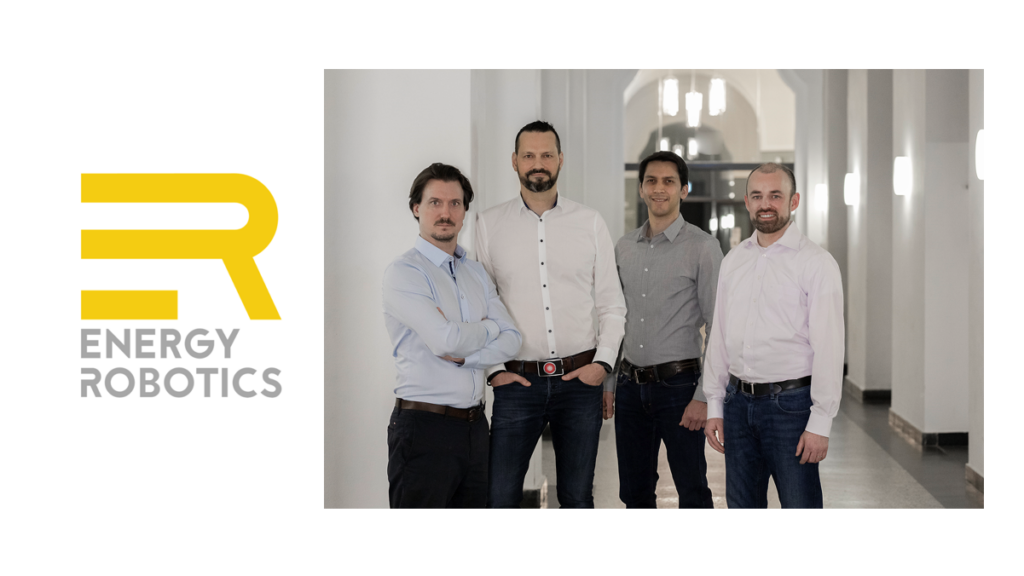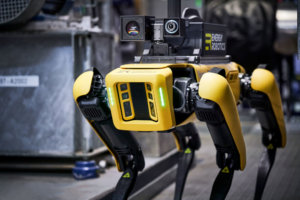How autonomous robots are making our industry safer
Katharina Kittelberger
Who are the future employees of the month? Autonomous Robots! Energy Robotics is the first company that offers a commercially available software solution for intelligent robot control and cloud-based fleet management of autonomous mobile ground robots for remote inspection and monitoring. These are primarily used in harsh and demanding environments such as the oil, gas and petrochemical industries. Power, solar and water plants are gradually following.
The team of experts has won several of the most important international competitions for autonomous robots for remote inspection in recent years. The initiative was sponsored by Merck, a leading science and technology company, and Boston Dynamics, a global leader in the development and deployment of highly mobile robots. "Innovation is not a sprint, it's a marathon," says Marc Dassler, CEO and CO-Founder. In an interview with 5-HT, he tells us how Energy Robotics trains its endurance.
 The Energy Robotics team: f. l. t. r. Dr. Dorian Scholz, Marc Dassler, Dr. Alberto Romay, Dr. Stefan Kohlbrecher
The Energy Robotics team: f. l. t. r. Dr. Dorian Scholz, Marc Dassler, Dr. Alberto Romay, Dr. Stefan KohlbrecherJust to get it right: what exactly does Energy Robotics do?
"Basically, we develop control software that performs industrial inspection tasks. After more than twenty years in research, we founded Energy Robotics in 2019 as a spin-off of the Technical University of Darmstadt. In the meantime, we are the leading company for the control of autonomous, mobile robots in industrial applications."
Routine inspections, safety & monitoring: What is the ulterior motive behind the development of autonomous robots?
"In general, robots can perform certain routine inspections in a more accurate way, than humans. Whether it's due to a person's physical limitations or even a hostile environment for humans. The latter mainly means that nowadays many workers still work in dangerous environments where accidents happen every day. These can be dangerous to both health and life. We are also active in the field of safety monitoring, for example for large industrial plants."
All right, but humans have been doing such work for centuries. Why change this now?
"Of course, but on the one hand, by using robots, we reduce costs on the inspection side. On the other hand, we increase safety because we remove humans from these dangerous environments. Ultimately, we increase the quality of the inspection because humans are simply not made for this type of work. After too many repetitions, they quickly overlook the fact that this screw needs to be tightened or that pipe has a defect. A robot is much more error-free than a human.
Robots react a factor of 1,000 earlier than humans.
"This goes hand in hand with the fact that downtimes can be prevented. The fact that robots react more sensitively to, for example, gas leaks means that these problems can be addressed at an early stage. In addition to emissions, this saves costs, time and a lot of money. If unnoticed faults can be prevented, it doesn't come to the point where an entire factory has to be shut down."
Doesn't this replace us human beings?
"On the contrary. The shortage of skilled workers in Western nations due to demographic change is a huge problem. The positions of our current inspectors need to be backfilled. To maintain our prosperity, we need digitization and autonomization. Therefore, it makes sense to hand over work to robots so that humans can concentrate on the areas in which they are better than any autonomous technology."
The robot Spot, which you developed together with your partner Boston Dynamics, was tested in Europe for the first time by the company Merck. How was it?
"It was a complete success. We designed an automated path for Spot through Mercks' multi-level facility. The result was a smooth and successful mission that lasted an hour in total, during which Spot completed a course in which he also negotiated industrial stairs without any problems."
 Energy Robotics has equipped Spot with thermal and zoom cameras, 4G wireless communications, onboard computing and its software suite to perform supervised autonomous inspection rounds.
Energy Robotics has equipped Spot with thermal and zoom cameras, 4G wireless communications, onboard computing and its software suite to perform supervised autonomous inspection rounds.Where else are your robots generally used?
"Anywhere inspections are needed and where they can be, or need to be, automated. It is rather unusual to invest a lot of money again in an already existing industrial infrastructure to modernize it. This means that, for example, IoT is not applied everywhere it would be necessary for cost reasons.
Our robots are a more flexible and also more cost-effective solution here.
"The special feature is that our robots are used in environments where previously only humans were active."
A confident look to the future?
"For sure. We currently already have three robot models on the market. Two more will follow in the coming months. One of them is a drone that can be used to monitor factory premises in particular. Through this dynamic system, we are now solving the "blind spot" problem, because when an abnormality is perceived, our robot reacts and alerts the security team, for example. We are also researching VR goggles that can be used to control our robots. This will allow autonomous manipulation tasks to be performed in the future."
In spite of all the technology and autonomy, the sole decision remains with the human.
Preparing for the marathon - Advice for founders
"Particular attention should be paid to three things. One is to make sure that the process is a roller coaster ride. Everyone has successful moments and those when they are devastated. These ups and downs repeat themselves every day.
On the other hand, it takes stamina as well as faith in one's own idea, which must be defended in every situation. Of course, reliable co-founders and team members are also irreplaceable. It should be clear from the outset that startups are a highly dynamic environment. Someone who can't navigate this chaos or loses sight of the vision will have a hard time getting there.
Also, one's own strengths should be under control to the extent that the marathon can be mastered. Because there's no point in shooting all your powder right at the start."
Do you see 5-HT as a suitable sponsor?
"Definitely. The 5-HT approach is great, because in my opinion, Germany as a business location needs to be strengthened and reinvented in terms of innovation. There should be a lot more barriers removed that prevent startups from getting innovations off the ground."
Germany has not yet used its innovation potential.
We see 5-HT as an important component that will drive this forward
more strongly in the future.
"Startups also have the opportunity to act much more quickly. In comparison, a large company is ponderous and can't simply push through many things. Nevertheless, cooperation between the two sides is important. We find that 5-HT's initiative also brings us closer to the industry in practical terms."
42.2 kilometers can be endlessly arduous - but they don’t have to be. The right attitude, motivated partners and supportive framework conditions are prerequisites for success.
In the meantime, Energy Robotics enjoys the tailwind provided by 5-HT.
5-HT Chemistry & Health Newsletter
Want the latest tech and industry news, events, relevant info from the ecosystem and more?
Subscribe to 5-HT Newsletter now Subscribe to 5-HT Newsletter now
Become part of the 5-HT Chemistry & Health
Exchange ideas with innovative startups and future-oriented companies in our ecosystem. We look forward to meeting you!